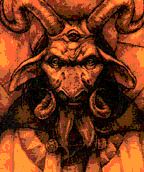The Ideal of Evil in Musick

The modern age of Music is filled with a vast myriad pagentry of blasphemy;
Occult symbolism, human altars, corpse bleached flesh, sin inspired lyrics,
a complete bestiary of wickedness and debauchary so pervasive in society
that it threatens to become commonplace. Even though at first glance it
seems as though the black-gates have been breached and from the very mouth
of hell demonspawn have awoken to walk among the living dead for the first
time, upon closer examination we find that not only are we not the first
to tread such unholy ground, but that among those who have best characterized
the manifestation of the dark side in human form are numbered some of
the most virtuosic creative musickal geniuses the underworld has ever
spawned forth.
Throughout history, some of the most powerful works
of Musickal creation have been crafted upon the ideal of evil made manifest
in musickal formulae. Mussorgsky's "A Night on Bald Mountain",
Franz Liszt's "A Faust Symphony" and "Mephisto Waltz",
Tartini's "The Devil's Trill", Camille Saint-Saens' "Danse
Macabre", Berlioz "Symphonie Fantastique", Stravinsky's
"The Devil's Dance" .... the liszt goes on, a true herald of
the power inherent in the darker aspect of human nature.
But the evocation of Evil through the creation of musickal thematic material
and sinister overtones is only the most apparent aspect of the debaucherous
spirits of some of histories greatest composers. In a day and age where
the donning of a Black Metal Hoody fashioned with diabolic scriptures
and Infernal beasts is as common a sight at a metal venue as a bottle
of cheap beer, our infernal forefathers shrouded themselves in mystery
and superstition, catering to and evolving the diabolic aesthetics for
which they were infamous. One of the most truly ingenius and successful
practitioners of this sorcerous craft was an Italian Violinist named Niccolo
Paganini.

Niccolo Paganini (1782-1840) was born in Genoa, Italy.
As with many successful musickians of his day, Paganini was forced to
spend a majority of his early life practicing at the violin. This nurtured
a creative genius that was already staggering by the time he was 16, by
which time he had already completed his 24 Caprices, his most famous surviving
works. What set Paganini apart from many of his contemperaries was his
natural affinity for stagemanship and a flair for the darkside. He grew
his hair long and dyed it with natural blackening dyes, was known for
dressing in untidy dark clothes
including a full length jacket in which it was said he carried brimstone
so that he would smell of the fires of hell. When on stage his skeletal
thin, gaunt appearance was magnified by the usage of a single candle for
illumination of his frame as he swayed on stage, astounding the audience
with his prodigious feats of virtuosic playing. His technique was incomparable;
so inhumanely advanced was his playing ability and style that it was widely
rumored he had sold his soul to the devil in exchange for his abilities,
compounded with the fact that he has murdered his mistress in order to
fashion her intestines into violin strings.
Yet another evocator of infernal conjurations was
a fellow Italian, Guiseppe Tartini (1692-1770, the year of Beethoven's
birth) whose most famous Violin Sonata, 'the Devil's Trill' is another
fine example of crafting the subconscious allure of the dark and the dramatic
into a Faustian twist. Tartini claimed that one night while he slept,
the Devil appeared to him with violin in hand, and proceeded to play the
most unearthly beautiful sonata Tartini had ever heard. Immediately he
awoke,
rushed to his bedside table, and feverishly penned down as much of the
diabolical tune as he could remember, the remains of which became 'The
Devils Trill'.

Indeed, the Devil has always been a popular figure
in classical musick, and no more so than in the archtypal figure of Mephistopheles.
Franz Liszt, Richard Wagner, Hector Berlioz, Gustav Mahler, Charles Gounod,
have all delved into the enticement and sinful allure of the proverbial
deal with the devil. Stemming from the real life exploits of one Doctor
Johannes Faust, a 16th century German medical practitioner who also dabbled
in astrology and alchemy. Rumours abounded of his
dealings with demons and his practice with black magic and necromancy.
After his death stories spread of his pact with the devil leading to his
ultimate downfall.
These stories serve to showcase but one aspect of creation, that of musick,
and how through the cultivation and utilization of the darker forces inherent
in mankinds psychology the elements of taboo, wonder, and the supernatural
combine to create a powerful force which is timeless in its ability to
captivate and invoke the magnificance and grandeur the Ideal of Evil represents.
LE' RUE DELASHAY